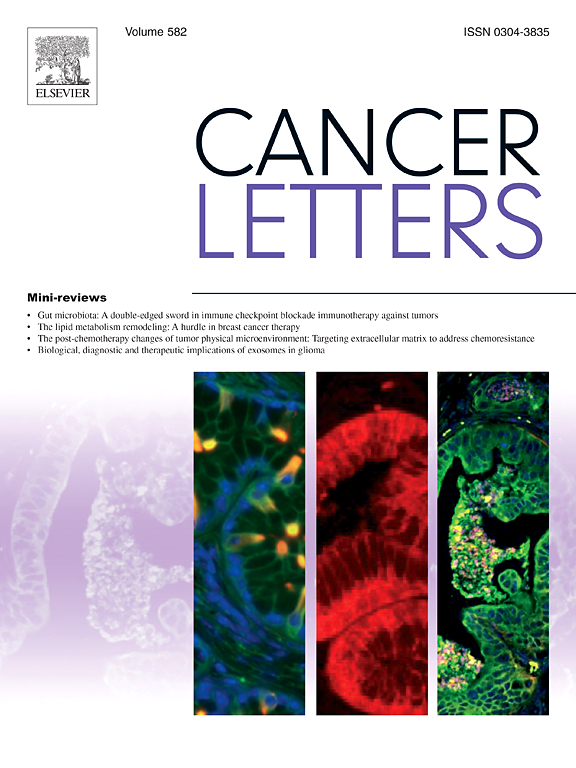蓝核蛋白协同靶向FASN和HMGCS1,通过脂质代谢重组和阻断GPX4生物合成,增强肿瘤细胞铁下垂敏感性
IF 10.1
1区 医学
Q1 ONCOLOGY
引用次数: 0
摘要
铁下垂是一种由脂质过氧化驱动的铁依赖性细胞死亡形式,已成为癌症治疗的一个有希望的靶点。然而,越来越多的证据表明,肿瘤细胞对经典的铁下垂诱导剂不敏感。在本研究中,通过对代谢物库的高通量筛选,我们确定了蓝草蛋白是一种有效的铁下垂致敏剂。在机制上,蓝蓝蛋白双重靶向脂肪酸合成酶(FASN)和羟甲基戊二酰辅酶a合成酶1 (HMGCS1),从而抑制它们的酶活性。FASN抑制出乎意料地通过抑制肉碱o -棕榈酰基转移酶1 (CPT1)介导的脂质β-氧化促进铁死亡,从而触发多不饱和脂肪酸(PUFA)积累驱动铁死亡。同时,HMGCS1抑制破坏甲羟戊酸途径,导致硒代半胱氨酸tRNA成熟受损,进而抑制谷胱甘肽过氧化物酶4 (GPX4)蛋白的合成,从而增强肿瘤细胞对铁凋亡诱导剂的敏感性。TCGA数据集的临床生物信息学分析显示,溶质载体家族7成员11 (SLC7A11)、FASN和HMGCS1在多种恶性肿瘤中显著共过表达,与患者生存率低相关。在体内,蓝蓝蛋白与经典的铁下垂诱导剂erastin协同抑制异种移植物肿瘤生长,无明显毒性。总的来说,本研究揭示了蓝蓝蛋白双靶点FASN/HMGCS1,并获得了显著的促铁下垂特性,为精确癌症治疗提供了一种机制独特的治疗范式。本文章由计算机程序翻译,如有差异,请以英文原文为准。
Synergistic targeting of FASN and HMGCS1 by cerulenin enhances tumor cell ferroptosis sensitivity through rewiring lipid metabolism and blocking GPX4 biosynthesis
Ferroptosis, an iron-dependent form of regulated cell death driven by lipid peroxidation, has emerged as a promising therapeutic target for cancer. However, accumulating evidence indicates that tumor cells exhibit insensitivity to classic ferroptosis inducers. In the present study, through high-throughput screening of a metabolite library, we identified cerulenin as a potent ferroptosis sensitizer. Mechanistically, cerulenin dually targets fatty acid synthase (FASN) and hydroxymethylglutaryl-CoA synthase 1 (HMGCS1), thereby inhibiting their enzymatic activity. FASN inhibition unexpectedly promoted ferroptosis via suppressing carnitine O-palmitoyltransferase 1 (CPT1)-mediated lipid β-oxidation, thereby triggering polyunsaturated fatty acid (PUFA) accumulation to drive ferroptosis. Simultaneously, HMGCS1 inhibition disrupted the mevalonate pathway, leading to impaired selenocysteine tRNA maturation and subsequent suppressing the synthesis of the glutathione peroxidase 4 (GPX4) protein, which enhances the sensitivity of tumor cells to ferroptosis inducers. Clinical bioinformatics analysis of TCGA datasets revealed significant co-overexpression of solute carrier family 7 member 11 (SLC7A11), FASN, and HMGCS1 in multiple malignancies, which correlated with poor patient survival rates. In vivo, cerulenin synergized with classic ferroptosis inducer erastin to suppress xenograft tumor growth without observable toxicity. Collectively, this study revealed that cerulenin dual-targets FASN/HMGCS1 and obtained with remarkable pro-ferroptosis properties, providing a mechanistically distinct therapeutic paradigm for precision cancer therapy.
求助全文
通过发布文献求助,成功后即可免费获取论文全文。
去求助
来源期刊

Cancer letters
医学-肿瘤学
CiteScore
17.70
自引率
2.10%
发文量
427
审稿时长
15 days
期刊介绍:
Cancer Letters is a reputable international journal that serves as a platform for significant and original contributions in cancer research. The journal welcomes both full-length articles and Mini Reviews in the wide-ranging field of basic and translational oncology. Furthermore, it frequently presents Special Issues that shed light on current and topical areas in cancer research.
Cancer Letters is highly interested in various fundamental aspects that can cater to a diverse readership. These areas include the molecular genetics and cell biology of cancer, radiation biology, molecular pathology, hormones and cancer, viral oncology, metastasis, and chemoprevention. The journal actively focuses on experimental therapeutics, particularly the advancement of targeted therapies for personalized cancer medicine, such as metronomic chemotherapy.
By publishing groundbreaking research and promoting advancements in cancer treatments, Cancer Letters aims to actively contribute to the fight against cancer and the improvement of patient outcomes.
 求助内容:
求助内容: 应助结果提醒方式:
应助结果提醒方式:


